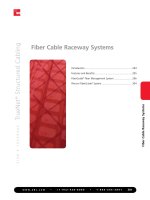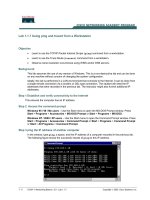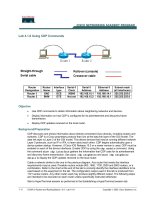Tài liệu Resolving Host Names by Using Domain Name System (DNS) doc
Bạn đang xem bản rút gọn của tài liệu. Xem và tải ngay bản đầy đủ của tài liệu tại đây (1 MB, 53 trang )
Module 4: Resolving Host
Names by Using Domain
Name System (DNS)
Overview
Multimedia: The Role of DNS in the Network
Infrastructure
Installing the DNS Server Service
Configuring the Properties for the DNS Server Service
Configuring DNS Zones
Configuring DNS Zone Transfers
Configuring DNS Dynamic Updates
Configuring a DNS Client
Delegating Authority for Zones
Multimedia: The Role of DNS in the Network
Infrastructure
The objective of this presentation is to
provide a high-level overview of DNS in
the network infrastructure
At the end of this presentation, you will be
able to:
y Explain the role and benefits of DNS in
the network infrastructure
y Define the key components of DNS
y Discuss the DNS domain namespace
y Discuss DNS zones and zone transfer
y Discuss DNS name servers
y Explain how the hosts name resolution
process works
y Explain forward lookup queries
Lesson: Installing the DNS Server Service
Overview of Domain Name System
What Is a Domain Namespace?
Standards for DNS Naming
How to Install the DNS Server Service
Overview of Domain Name System
Domain Name System (DNS) is a hierarchical, distributed database
that contains mappings of DNS domain names to various types of
data, such as IP addresses
Domain Name System (DNS) is a hierarchical, distributed database
that contains mappings of DNS domain names to various types of
data, such as IP addresses
DNS is the foundation of the Internet naming scheme and the
foundation of an organization’s naming scheme
DNS supports accessing resources by using alphanumeric names
InterNIC is responsible for delegating administrative responsibility
for portions of the domain namespace and for registering domain
names
DNS was designed to solve issues that arose when there was an
increase in the:
y Number of hosts on the Internet
y Traffic generated by the update process
y Size of the Hosts file
What Is a Domain Namespace?
Root Domain
Root Domain
Subdomains
Subdomains
Second
Second
-
-
Level Domain
Level Domain
Top
Top
-
-
Level Domain
Level Domain
FQDN:
server1.sales.south.nwtraders.com
FQDN:
server1.sales.south.nwtraders.com
south
south
nwtraders
nwtraders
com
com
sales
sales
west
west
east
east
org
org
net
net
Host: server1
Host: server1
Standards for DNS Naming
The following characters are valid for DNS names:
A-Z
a-z
0-9
Hyphen (-)
The underscore (_) is a reserved character
How to Install the DNS Server Service
Your instructor will demonstrate how to install the DNS
Server service
Your instructor will demonstrate how to install the DNS
Server service
Practice: Installing the DNS Server Service
In this practice, you will install the DNS
Server service
Lesson: Configuring the Properties for the DNS Server
Service
What Are the Components of a DNS Solution?
What Is a DNS Query?
How Recursive Queries Work
How a Root Hint Works
How Iterative Queries Work
How Forwarders Work
How DNS Server Caching Works
How to Configure the Properties for the DNS Server
Service
What Are the Components of a DNS Solution?
DNS Servers on the InternetDNS ServersDNS Clients
Root “.”
Root “.”
.com
.com
.edu
.edu
Resource
Record
Resource
Record
Resource
Record
Resource
Record
What Is a DNS Query?
DNS clients and DNS servers both initiate queries for name
resolution
An authoritative DNS server for the namespace of the query
will either:
y Check the cache, check the zone, and return the requested IP
address
y Return an authoritative, “No”
A non-authoritative DNS server for the namespace of the
query will either:
y Forward the unresolvable query to a specific query server
called a Forwarder
y Use root hints to locate an answer for the query
A query is a request for name resolution to a DNS server. There are
two types of queries: recursive and iterative
A query is a request for name resolution to a DNS server. There are
two types of queries: recursive and iterative
How Recursive Queries Work
Computer1
Computer1
Recursive query for
mail1.nwtraders.com
172.16.64.11
A recursive query is a query made to a DNS server, in which the DNS
client asks the DNS server to provide a complete answer to the query
A recursive query is a query made to a DNS server, in which the DNS
client asks the DNS server to provide a complete answer to the query
DNS server checks the forward lookup
zone and cache for an answer to the query
DNS server checks the forward lookup
zone and cache for an answer to the query
Database
Local DNS Server
Local DNS Server
How Root Hint Works
Root hints are DNS resource records stored on a DNS server that list
the IP addresses for the DNS root servers
Root hints are DNS resource records stored on a DNS server that list
the IP addresses for the DNS root servers
microsoft
microsoft
Cluster of
DNS Servers
Cluster of
DNS Servers
Root Hints
Root Hints
DNS Server
DNS Server
Cluster of
Root (.) Servers
Cluster of
Root (.) Servers
com
com
Computer1
Computer1
How Iterative Queries Work
An iterative query is a query made to a DNS server in which the DNS client
requests the best answer that the DNS server can provide without seeking
further help from other DNS servers. The result of an iterative query is often a
referral to another DNS server lower in the DNS tree
An iterative query is a query made to a DNS server in which the DNS client
requests the best answer that the DNS server can provide without seeking
further help from other DNS servers. The result of an iterative query is often a
referral to another DNS server lower in the DNS tree
Computer1
Computer1
Local
DNS Server
Local
DNS Server
nwtraders.com
nwtraders.com
Root Hint (.)
Root Hint (.)
.com
.com
R
ecur
s
i
v
e
q
u
e
r
y
f
o
r
m
a
i
l
1.
n
w
t
r
a
d
e
r
s
.
c
o
m
1
7
2
.
1
6.
6
4
.
1
1
Iterative Query
I
t
e
rat
i
ve
Q
ue
ry
It
e
r
a
t
iv
e
Q
u
e
r
y
Ask .com
A
s
k
n
w
tr
a
d
e
r
s
.c
o
m
Au
th
o
r
i
ta
ti
v
e
Re
s
p
o
n
s
e
3
3
2
2
1
1
How Forwarders Work
A forwarder is a DNS server designated by other internal DNS servers to
forward queries for resolving external or offsite DNS domain names
A forwarder is a DNS server designated by other internal DNS servers to
forward queries for resolving external or offsite DNS domain names
Computer1
Computer1
nwtraders.com
nwtraders.com
Root Hint (.)
Root Hint (.)
.com
.com
Iterative Query
I
t
e
rat
i
ve
Q
ue
ry
It
e
r
a
t
iv
e
Q
u
e
r
y
Ask .com
A
s
k
n
w
tr
a
d
e
r
s
.c
o
m
Au
th
o
r
i
ta
ti
v
e
Re
s
p
o
n
s
e
Local
DNS Server
Local
DNS Server
Forwarder
Forwarder
R
e
c
u
rsive
q
u
er
y f
o
r
m
a
i
l
1
.n
w
tra
d
e
r
s.c
o
m
1
7
2
.
1
6.
64
.
1
1
1
7
2
.1
6
.6
4
.1
1
R
ec
u
r
si
v
e
Q
u
e
ry
How DNS Server Caching Works
Caching is the process of temporarily storing recently accessed information
in a special memory subsystem for quicker access
Caching is the process of temporarily storing recently accessed information
in a special memory subsystem for quicker access
Where’s Client
A?
Where’s Client
A?
Client1
Client1
Client2
Client2
ClientA
ClientA
ClientA is at
192.168.8.44
ClientA is at
192.168.8.44
Where’s Client
A?
Where’s Client
A?
ClientA is at
192.168.8.44
ClientA is at
192.168.8.44
Caching Table
Host Name
IP Address TTL
192.168.8.44 28 secondsclientA.contoso.msft.
How to Configure Properties for the DNS Server Service
Your instructor will demonstrate how to:
Your instructor will demonstrate how to:
Update root hints on a DNS server
Configure a DNS server to use a forwarder
Clear the DNS server cache by using the DNS console
Clear the DNS server cache by using the DNSCmd
command
Update root hints on a DNS server
Configure a DNS server to use a forwarder
Clear the DNS server cache by using the DNS console
Clear the DNS server cache by using the DNSCmd
command
Practice: Configuring Properties for the DNS Server
Service
In this practice, you will configure the
properties for the DNS Server service
Lesson: Configuring DNS Zones
How DNS Data Is Stored and Maintained
What Are Resource Records and Record Types?
What Is a DNS Zone?
What Are DNS Zone Types?
How to Change a DNS Zone Type
What Are Forward and Reverse Lookup Zones?
How to Configure Forward and Reverse Lookup Zones
How DNS Data Is Stored and Maintained
DNS Server
DNS Server
Zone File:
Zone File:
Training.nwtraders.msft.dns
Training.nwtraders.msft.dns
DNS ClientA
DNS ClientA
Resource records for the zone
training.nwtraders.msft
Host name
IP address
DNS ClientA 192.168.2.45
DNS ClientB 192.168.2.46
DNS ClientC 192.168.2.47
DNS ClientB
DNS ClientB
DNS ClientC
DNS ClientC
Namespace: training.nwtraders.msft
A resource record (RR) is a standard DNS database structure containing information
used to process DNS queries
A resource record (RR) is a standard DNS database structure containing information
used to process DNS queries
A zone is a portion of the DNS database that contains the resource records with the
owner names that belong to the contiguous portion of the DNS namespace
A zone is a portion of the DNS database that contains the resource records with the
owner names that belong to the contiguous portion of the DNS namespace
What Are Resource Records and Record Types?
Record type Description
A
Resolves a host name to an IP address
Resolves an IP address to a host name
The first record in any zone file
SRV
Resolves names of servers providing services
CNAME
Resolves from a host name to a host name
Identifies the DNS server for each zone
MX
The mail server
NS
PTR
SOA
What Is a DNS Zone?
Nwtraders
Nwtraders
West
West
South
South
Support
Support
Sales
Sales
Training
Training
North
North
What Are DNS Zone Types?
Zones Description
Primary
Read/write copy of a DNS database
Stub
Copy of a zone containing limited records
Secondary
Read-only copy of a DNS database
Read/Write
Read-Only
Copy of
limited
records
How to Change a DNS Zone Type
Your instructor will demonstrate how to change a DNS
zone type
Your instructor will demonstrate how to change a DNS
zone type









